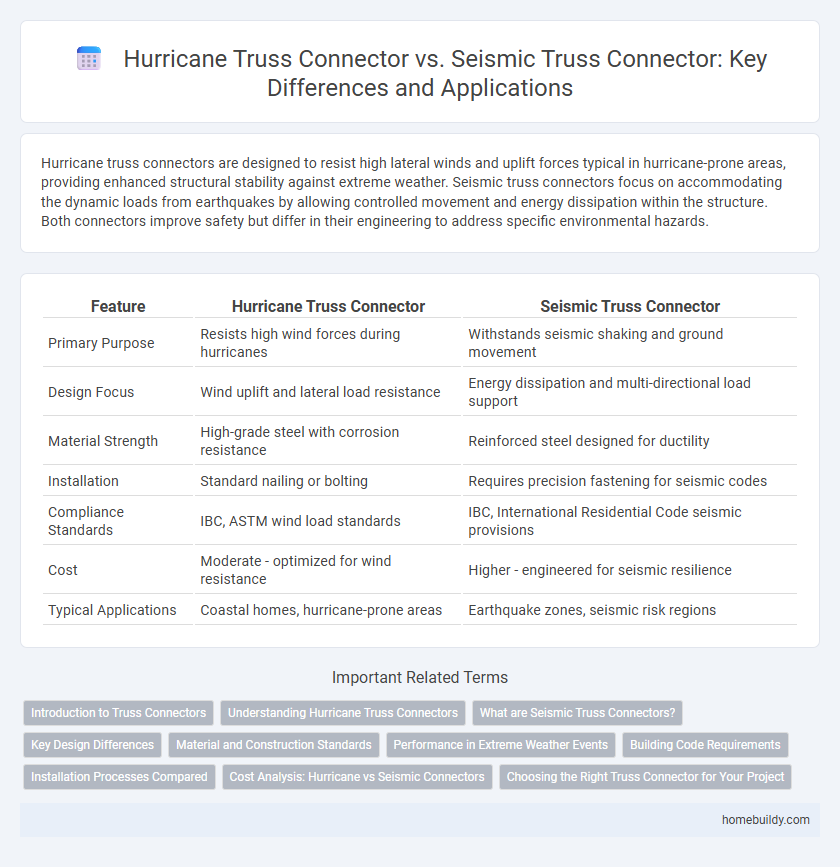Hurricane truss connectors are designed to resist high lateral winds and uplift forces typical in hurricane-prone areas, providing enhanced structural stability against extreme weather. Seismic truss connectors focus on accommodating the dynamic loads from earthquakes by allowing controlled movement and energy dissipation within the structure. Both connectors improve safety but differ in their engineering to address specific environmental hazards.
Table of Comparison
| Feature | Hurricane Truss Connector | Seismic Truss Connector |
|---|---|---|
| Primary Purpose | Resists high wind forces during hurricanes | Withstands seismic shaking and ground movement |
| Design Focus | Wind uplift and lateral load resistance | Energy dissipation and multi-directional load support |
| Material Strength | High-grade steel with corrosion resistance | Reinforced steel designed for ductility |
| Installation | Standard nailing or bolting | Requires precision fastening for seismic codes |
| Compliance Standards | IBC, ASTM wind load standards | IBC, International Residential Code seismic provisions |
| Cost | Moderate - optimized for wind resistance | Higher - engineered for seismic resilience |
| Typical Applications | Coastal homes, hurricane-prone areas | Earthquake zones, seismic risk regions |
Introduction to Truss Connectors
Truss connectors play a critical role in maintaining structural integrity by securely joining truss components in buildings. Hurricane truss connectors are engineered to withstand extreme wind forces typical of hurricane-prone regions, featuring reinforced materials and corrosion-resistant coatings. Seismic truss connectors are specifically designed to accommodate dynamic lateral loads and provide flexibility during earthquakes, minimizing structural damage through enhanced energy dissipation properties.
Understanding Hurricane Truss Connectors
Hurricane truss connectors are engineered to provide enhanced resistance against extreme wind forces by securely anchoring roof trusses to walls, minimizing uplift and lateral movement during hurricanes. These connectors feature corrosion-resistant coatings and robust metal gauges tailored to withstand prolonged exposure to moisture and high-velocity winds. Unlike seismic truss connectors, which prioritize flexibility and energy absorption during earthquakes, hurricane truss connectors emphasize rigid strength and load distribution to protect structures in hurricane-prone regions.
What are Seismic Truss Connectors?
Seismic truss connectors are specialized hardware designed to enhance the structural integrity of truss systems during earthquakes by accommodating lateral and vertical movements. These connectors comply with stringent seismic building codes, ensuring that trusses remain securely fastened and reduce the risk of collapse or damage under seismic forces. Engineered with robust materials and unique geometries, seismic truss connectors provide superior load transfer, energy dissipation, and flexibility compared to standard hurricane truss connectors.
Key Design Differences
Hurricane truss connectors are engineered to withstand high wind loads by emphasizing enhanced uplift resistance and lateral load transfer through corrosion-resistant materials and reinforced metal plates. Seismic truss connectors prioritize flexibility and energy dissipation, incorporating ductile connectors and specialized fasteners to accommodate ground motion and reduce structural damage during earthquakes. Both types feature unique design criteria tailored to their respective hazard demands, focusing on the connection's ability to maintain integrity under extreme dynamic forces.
Material and Construction Standards
Hurricane truss connectors are typically manufactured from galvanized steel designed to meet ASTM A653 standards, ensuring high corrosion resistance and durability in extreme wind conditions. Seismic truss connectors adhere to stricter material specifications under ASTM A1011 to provide enhanced ductility and energy absorption during earthquakes. Both types comply with ICC-ES Evaluation Reports but differ in construction standards to address their respective environmental hazards effectively.
Performance in Extreme Weather Events
Hurricane truss connectors are engineered to withstand high wind speeds exceeding 130 mph, providing superior resistance to uplift and lateral forces during hurricanes. Seismic truss connectors focus on flexibility and energy dissipation to prevent structural failure during earthquakes, accommodating ground shaking and movement. Performance in extreme weather events depends on the specific environmental forces, with hurricane connectors excelling against wind loads and seismic connectors optimized for seismic activity.
Building Code Requirements
Hurricane truss connectors are engineered to meet stringent wind load requirements outlined in building codes such as ASCE 7, ensuring structural integrity against extreme wind forces. Seismic truss connectors comply with seismic design provisions in codes like the International Building Code (IBC) and ASCE 7, focusing on lateral force resistance and ductility during earthquakes. Selection between these connectors depends on regional hazard maps and code mandates specifying wind speed zones or seismic design categories for safe structural performance.
Installation Processes Compared
Hurricane truss connectors typically require corrosion-resistant materials and enhanced fastening techniques to withstand high wind forces, involving the use of longer nails or specialized screws during installation. Seismic truss connectors demand flexible yet strong connections to absorb earthquake energy, often incorporating gusset plates and additional bolting for lateral load resistance. Installation of seismic connectors generally involves more precise alignment and torque specifications to maintain structural integrity during seismic events.
Cost Analysis: Hurricane vs Seismic Connectors
Hurricane truss connectors typically involve lower initial costs compared to seismic truss connectors due to simpler design and less stringent engineering requirements. Seismic truss connectors require advanced materials and enhanced structural features to withstand earthquake forces, driving up the overall investment. Long-term cost analysis often favors seismic connectors in high-risk zones by reducing potential damage and repair expenses from seismic events.
Choosing the Right Truss Connector for Your Project
Hurricane truss connectors are engineered to withstand extreme wind loads, providing robust lateral stability crucial in coastal regions prone to storms. Seismic truss connectors focus on flexibility and energy dissipation, designed to endure ground shaking and prevent structural failure during earthquakes. Selecting the appropriate truss connector involves analyzing local environmental risks and compliance with building codes such as the International Building Code (IBC) for seismic zones or ASCE 7 for wind loads.
Hurricane truss connector vs seismic truss connector Infographic

 homebuildy.com
homebuildy.com